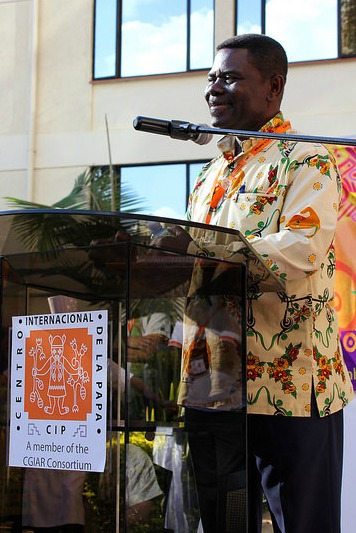Dr. Hans Adu Dapaah is a plant breeder and was the director of the Council for Scientific and Industrial Research (CSIR) – Crops Research

Institute (CRI), Ghana from 2008 to 2014. He is now the Chief Research Scientist at the CSIR – CRI. After the inaugural meeting of the re-vamped Sweetpotato for Profit and Health Initiative (SPHI) Steering Committee in October 2015 in Kigali, Christine Bukania caught up with the outgoing interim chairman. Here is what he had to say about his experience as the former chair of the SPHI Phase 1 Executive Steering Committee (ESC) and the interim chair for the new structure.
Briefly tell me what your involvement with SPHI has been?
I have been involved since the inception of CIP’s Sweetpotato for Security and Health in Africa (SASHA) project. I was among the members who designed the project and I went to Uganda for the inauguration. Since then I have represented the West Africa sub-region, which is one of three sub-regions that was represented on the steering committee. After Year 2, I was appointed chair of the ESC. The ESC oversaw both the SASHA Project and the broader SPHI.
In 2013, I was part of the team that went to Seattle to prepare for the second phase. We held a meeting in Ghana, where it became clear that in the second phase, we should decouple the governance of the SASHA project and SPHI. We developed a concept note and invited comments from all the stakeholders who were gathered at the meeting in Ghana. Following that, we presented it to the Steering Committee in the 2014 meeting, and then we fine-tuned the Terms of Reference. We also identified potential members of the steering committees of the SASHA Project Advisory Committee and the SPHI Steering Committee; I was appointed the interim steering committee chair. Today, my role as the interim chair has officially come to an end.
What are some core responsibilities you performed as the chair?
I helped to set the agenda of the SPHI meeting. Each member of the Steering Committee assessed progress that had been made in each sector of the project. The first time, I was assigned the Seed Systems component. We met with the management team to give our comments and allowed them to give their response. The objective of this exercise is to fine-tune what the management and project teams are doing.
I have really enjoyed working with the SPHI team. Phase 2 has started well and I’m confident that we will be able to reach the target. There has been an impression that this was a CIP affair, so we need to disabuse everyone of this notion because it is when everyone comes on board that we will be able to achieve the target that we have set ourselves. We need to build trust among the various partners. From the meeting that we had today, I believe that the members of the steering committee are going to play their role. The Communities of Practice (CoPs) should communicate. It is like a chain. We all need each other. The outcomes of each meeting should be made know to the other CoPs because some of their recommendations require action. We also need to align SPHI with NEPAD, ECOWAS and ASARECA, since all of them have a larger audience. We must have positive engagement with the media, who are able to speak the language of the general public.
How will your involvement in Phase 2 be?
The fact that I am no longer the chair does not mean that I have washed my hands off SPHI. Whatever role I can play at the national level, I will do it. I will not relent to speak about it at any forum that I am invited to. If it succeeds, it is to the credit of the entire team and I want to be part of the winning team. So I will play any advocacy role that I can.
What is the most memorable thing about your work to date?
To me, the formation of the CoPs is the most memorable and the best way to go. It brought members together and there was a cross-fertilization of ideas. These CoPs should be broadened to bring in national scientists and policy makers to be able to fast-track progress.
How do you think we can broaden the CoPs?
We should get more people to buy in at national, regional and global level. We need to look for best practices to be able to move the program forward. We should standardize the way we gather and define data so that when data is brought, we will be able to analyze and make meaningful inferences. We also need to package the data we have in a meaningful way that depicts the evidence we need to do advocacy. In Phase 1 we have had so much data that if it is well packaged the buy in will not be difficult.
SASHA Phase 1 built the capacity of scientists and the private sector, and we should continue to do this to increase efficiency. We also need to create an enabling environment for the youth to get more involved. I read from the African Green Revolution Forum that every year, 10 million youth enter the job market, and they don’t have jobs. If we create an enabling environment for them to buy into this initiative, we will make faster progress.